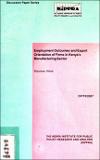Discussion Paper No. 78 of 2007 on Employment Outcomes and Export Orientation of Firms in Kenya's Manufacturing Sector
View/
Publication Date
2007Author
Type
KIPPRA Publicationsviews
downloads
Metadata
Show full item recordBy
Were, Maureen
Abstract/
Kenya's manufacturing sector accounts for over 10 per cent of GDP. Intensification of trade liberalization reforms in the 1990s saw the share of exporting firms increase. This seems to have coincided with a rise in use of temporary workers compared to permanent workers. Given the high level of unemployment and widespread poverty, the implications of such employment outcomes cannot be over-emphasized. Little attention has been given to Africa's trade and employment outcomes. This paper explores the employment outcomes in relation to firms' export-orientation. The main source of data are the surveys undertaken under the World Bank's project on "Regional Programme on Enterprise Development" (RPED) in early 1990s and in 2003. The analysis shows that the proportion of exporting firms in the manufacturing sector increased, with over 50 per cent of firms exporting their product(s) in 2003. Use of temporary workers also increased, with 36 per cent of workers being casual and part time employees. In general, there has been a shift towards a more skilled labour force, which is slightly higher for exporting (78%) than non-exporting firms (68%). Employment is male-dominated (over 80% are male), with exporting firms having a relatively higher proportion of female workers...
Publisher
The Kenya Institute for Public Policy Research and AnalysisSeries
DP/78/2007;Collections
- Discussion Papers [328]

